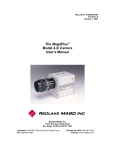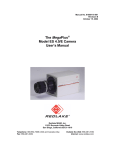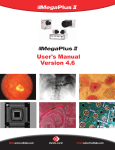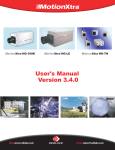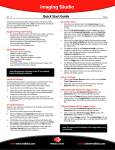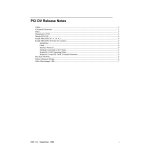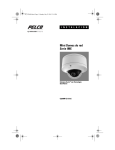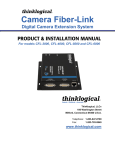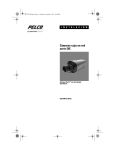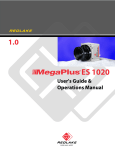Download Redlake MASD MegaPlus ES 4.0/E User`s manual
Transcript
Manual No. 91000064-004 Revision A August 29, 2001 The MegaPlusâ Model ES 1.0 Series Cameras User’s Manual (Models ES 1.0,ES 1.0/PIV, ES 1.0/SC, ES 1.0/10 Bit, ES 1.0/TH) Redlake MASD, Inc. 11633 Sorrento Valley Road San Diego, California 92121-1097 Telephone: 800-854-7006 (USA and Canada only) Fax: 858-481-6254. Outside the USA: 858 481-8182 Internet: www.redlake.com REDLAKE MASD, INC. List of Manual Revisions User’s Manual – Model ES 1.0 Series, Part Number 91000064-002 Revision Date A 08-29-01 EO No. Notes Reissued to reflect Redlake MASD, Inc. change, new flexible cable for tethered head, new format, and general cleanup. RELATED DOCUMENTS MegaPlus Model ES 1.0 Remote Control Panel User’s Manual, Part #91000074-001 FCC DECLARATION OF CONFORMITY This equipment has been tested and found to comply with the limits for a Class A digital device, pursuant to Subpart B of Part 15 of the FCC rules. These limits are designed to provide reasonable protection against harmful interference in a residential installation. This equipment generates, uses and can radiate radio frequency energy, and if not installed and used in accordance with the instructions, may cause harmful interference to radio communications. However, there is no guarantee that interference will not occur in a particular installation. If this equipment does cause harmful interference to radio or television reception, which can be determined by turning the equipment off and on, the user is encouraged to try to correct the interference by one or more of the following measures: · Reorient or relocate the receiving antenna. · Increase the separation between the equipment and receiver. · Connect the equipment into an outlet on a circuit different from that to which the receiver is connected. · Consult the dealer or an experienced radio/TV technician for help. This equipment has been certified to comply with the limits for a Class A computing device, pursuant to FCC rules. In order to maintain compliance with FCC regulations, shielded cables must be used with this equipment. Operation with non-approved equipment or unshielded cables is likely to result in interference to radio and TV reception. The user is cautioned that changes and modifications made to the equipment without the approval of the manufacturer could void the user’s authority to operate this equipment. Copyright ã 2001 Redlake MASD, Inc. The information in this manual is for information purposes only and is subject to change without notice. Redlake MASD, Inc. makes no warranty of any kind with regards to the information contained in this manual, including but not limited to implied warranties of merchantability and fitness for a particular purpose. Redlake MASD, Inc. shall not be liable for errors contained herein nor for incidental or consequential damages from the furnishing of this information. No part of this manual may be copied, reproduced, recorded, transmitted or translated without the express written permission of the Redlake MASD, Inc. 91000064-004 Revision A ii 8/29/01 MegaPlus® Model ES 1.0 PRECAUTIONS CAUTION: A laser beam focused on the sensor, either directly or by reflection, can cause permanent damage to the sensor. Any laser powerful enough to produce localized heating at the surface of the sensor will cause damage, even if the camera power is off. A sensor damaged by laser light is NOT covered by the warranty. NOTE: The ES 1.0 Series Cameras require a minimum of 10 minutes warm up time prior to operation. Images taken before the camera has warmed up sufficiently may show artifacts. Waiting until the camera has warmed up will ensure that the camera performs within specified parameters. OPERATING TEMPERATURE The MegaPlus camera is designed to operate satisfactorily in an environment where the ambient temperature is between 0° and 40°C (32° and 104°F), with no water condensation present. STORAGE TEMPERATURE Do not store the equipment in an area where the temperature will drop below –25°C (-13°F) or exceed 80°C (176°F). Do not allow moisture to condense on the system. SHIPPING When shipping, use a carton that protects the camera from shock and moisture, similar to the carton in which the unit was originally delivered. Do not ship the equipment in a cargo area where the temperature will drop below -25°C (-13°F) or exceed 80°C (176°F). Do not allow moisture to condense on the system. 91000064-004 Revision A iii USER’S MANUAL REDLAKE MASD, INC. TABLE OF CONTENTS 1. INTRODUCTION ............................................................................................................... 1-1 Introduction..................................................................................................................... 1-1 How to Use This Manual ................................................................................................ 1-1 2. CONTROLS AND CONNECTORS ................................................................................... 2-1 2.1 Camera........................................................................................................................... 2-1 2.1.1 Mounting the Camera ............................................................................................. 2-1 2.1.2 Attaching the Lens .................................................................................................. 2-1 2.2 Camera Rear Panel ....................................................................................................... 2-2 2.2.1 AIA Interface ........................................................................................................... 2-2 2.2.2 Trigger..................................................................................................................... 2-2 2.2.3 Strobe ..................................................................................................................... 2-2 2.2.4 DC Power Input....................................................................................................... 2-2 2.3 Cables ............................................................................................................................ 2-3 2.4 Hardware Setup ............................................................................................................. 2-4 2.5 Routine Maintenance ..................................................................................................... 2-5 3. CAMERA OPERATION ..................................................................................................... 3-1 3.1 Introduction..................................................................................................................... 3-1 3.2 Serial Communications Protocol .................................................................................... 3-1 3.3 Error Messages .............................................................................................................. 3-2 3.4 Control Commands ........................................................................................................ 3-2 3.4.1 Readout .................................................................................................................. 3-2 3.4.2 Mode Control .......................................................................................................... 3-2 3.4.3 Continuous .............................................................................................................. 3-3 3.4.4 Controlled................................................................................................................ 3-3 3.4.5 Trigger..................................................................................................................... 3-3 3.4.6 Triggered Double Exposure .................................................................................... 3-4 3.4.7 Mode ....................................................................................................................... 3-5 3.4.8 Exposure ................................................................................................................. 3-5 3.4.9 Trigger..................................................................................................................... 3-6 3.4.10 Transfer Pulse Delay .............................................................................................. 3-7 3.4.11 Transfer Pulse Width .............................................................................................. 3-7 3.4.12 Black Level.............................................................................................................. 3-8 3.4.13 Black Level Balance................................................................................................ 3-8 3.4.14 Digital Gain ............................................................................................................. 3-9 3.4.15 Gain Balance .......................................................................................................... 3-9 3.4.16 Restore Factory Settings ........................................................................................ 3-9 3.4.17 Strobe Polarity ...................................................................................................... 3-10 3.4.18 Defect Conceal ..................................................................................................... 3-10 3.4.19 Save ...................................................................................................................... 3-10 3.4.20 Reset..................................................................................................................... 3-10 3.4.21 Display Wedge...................................................................................................... 3-11 3.5 Query Commands ........................................................................................................ 3-11 3.5.1 Status Query ......................................................................................................... 3-11 3.5.2 Identification Query ............................................................................................... 3-12 4. INTERFACE SPECIFICATIONS ....................................................................................... 4-1 4.1 Introduction..................................................................................................................... 4-1 4.2 AIA Interface Connector................................................................................................. 4-1 4.3 Digital Video Outputs ..................................................................................................... 4-1 4.4 Timing Outputs ............................................................................................................... 4-1 4.5 Control Inputs ................................................................................................................. 4-1 4.6 Cable Descriptions ......................................................................................................... 4-3 4.7 Timing Waveforms ......................................................................................................... 4-8 4.8 Specifications ............................................................................................................... 4-10 1.1 1.2 91000064-004 Revision A iv 8/29/01 MegaPlus® Model ES 1.0 4.8.1 4.8.2 4.8.3 4.8.4 Video Performance ............................................................................................... 4-10 Camera Mechanical .............................................................................................. 4-10 Temperature ......................................................................................................... 4-10 Humidity ................................................................................................................ 4-10 LIST OF FIGURES Figure 2-1. Camera Body Bottom and Tethered Head Mounting Holes ....................................... 2-1 Figure 2-2. ES 1.0 Rear Panel ..................................................................................................... 2-2 Figure 2-3. ES 1.0 Cable Types ................................................................................................... 2-3 Figure 2-4. Component Connection Diagram............................................................................... 2-4 Figure 3-1. Triggered Double Exposure Timing........................................................................... 3-4 Figure 3-2. Wedge Display ..........................................................................................................3-11 Figure 4-1. AIA Interface Connector ............................................................................................. 4-2 Figure 4-2 AIA Interface Cable ..................................................................................................... 4-3 Figure 4-3. Interface Cable Figure 4-4. Interface Cable Connector...................................... 4-5 Figure 4-5. COM Port 9-Pin Cable Connector............................................................................. 4-5 Figure 4-6. 37-Pin Connector (ES 1.0/SC Only) ......................................................................... 4-6 Figure 4-7. COM Port 9-Pin Connector (ES 1.0/SC Only) ........................................................... 4-6 Figure 4-8. 37-Pin Interface Cable with 9-Pin COM Port Cable (ES 1.0/SC Only) ..................... 4-7 Figure 4-9. Continuous Mode – Variable Exposure Timing .......................................................... 4-8 Figure 4-10. Controlled Mode Timing ........................................................................................... 4-8 Figure 4-11. Triggered Mode Timing............................................................................................. 4-8 Figure 4-12. Triggered Double Exposure Mode Timing ............................................................... 4-9 Figure 4-13. Line Timing............................................................................................................... 4-9 Figure 4-14. Pixel Timing.............................................................................................................. 4-9 LIST OF TABLES Table 4-1. AIA Interface Connector Pin Out (on rear of camera).................................................. 4-2 Table 4-2. Interface Cable Pin Out, Mates with PC COM Port..................................................... 4-4 Table 4-3. 9-Pin Connector Pin Out............................................................................................. 4-5 Table 4-4. 37-Pin Interface Cable Pin Out (ES 1.0/SC Model Only) ........................................... 4-6 Table 4-5. COM Port 9-Pin Cable Pin Out (ES 1.0/SC Only) ...................................................... 4-6 91000064-004 Revision A v USER’S MANUAL REDLAKE MASD, INC. THIS PAGE INTENTIONALLY LEFT BLANK 91000064-004 Revision A vi 8/29/01 MegaPlus® Model ES 1.0 1. INTRODUCTION 1.1 Introduction With spatial resolution of one million pixels, 30 frames per second (fps), and dual channel progressive scan readout, the Redlake MASD, Inc. MegaPlus Camera, Model ES 1.0, is well suited for scientific and industrial imaging applications. The compact camera package operates through an AIA connection to a host computer. The AIA interface connector, located on the camera’s rear panel, sends eight-bit digital output video to the computer and receives control commands from the computer. Featuring an interline Charge Coupled Device (CCD) sensor array, the camera has 1,008 (H) x 1,018 (V) light sensitive elements (pixels). These pixels have a center-to-center spacing of 9 microns with a 60% fill ratio. The Model ES 1.0/PIV camera has been modified for use in particle image velocimetry. This model has an active pixel area of 900 (H) x 900 (V). The camera operates continuously or in a triggered mode. Minimum exposure times of 0.127 milliseconds are possible with the camera’s electronic shutter. The frame rate is unaffected by the exposure time. The camera has an output channel data rate of 20 MHz, which gives a maximum frame rate of 30 fps. The camera requires only eight watts of power and can be connected to many commercially available frame grabber boards capable of handling eight or ten bits of video data. The ES 1.0 camera’s triggered double exposure mode facilitates Particle Image Velocimetry (PIV). In dual channel mode, the camera outputs two lines of the image simultaneously. The camera is limited to single channel operation and 15 fps when ordered as a Redlake MASD, Inc. MegaPlus Camera, Model ES 1.0/SC. 1.2 How to Use This Manual WARNINGS, CAUTIONS and NOTES As you read this manual, you will notice that some of the information is presented as a WARNING, CAUTION or NOTE. It is important that you understand the significance of these terms. A WARNING is important to the safety of anyone operating the Camera and should not be disregarded under any circumstances. A CAUTION is intended to alert you to an operation or condition that may cause loss of data or harm to your Camera. A NOTE contains information that is important to the operation of your Camera. Chapter 1 contains an explanation of this manual and a warranty statement. Chapter 2 explains the function of the controls and connectors of the MegaPlus Camera. Chapter 3 contains the commands used to operate the camera. The camera is remotely operated by entering commands into a computer connected to the camera. Chapter 4 details the signals carried by the AIA interface connector, including timing waveforms. 91000064-004 Revision A 1-1 USER’S MANUAL REDLAKE MASD, INC. NEW EQUIPMENT WARRANTY REDLAKE MASD, INC. MEGAPLUS CAMERA REDLAKE MASD, INC. (HEREAFTER REFERRED TO AS REDLAKE) WARRANTS THIS CAMERA, AND ACCESSORIES MANUFACTURED BY REDLAKE, TO FUNCTION PROPERLY FOR ONE YEAR FROM THE DATE OF SHIPMENT. Redlake agrees to perform the following equipment warranty services in the United States. 1. Repair service: if shipped to us, repairs will be made at no charge. 2. Parts replacement: replacement parts installed under warranty will be provided at no charge. THIS WARRANTY DOES NOT APPLY TO THE FOLLOWING CONDITIONS: • Failure to operate the MegaPlus Camera, in accordance with Redlake’s written instructions, including environmental specifications listed in the User’s Manual. • Evidence of the Camera being subjected to accidental damage, misuse or abuse. • The Camera, having been repaired or tampered with by persons other than Redlake personnel, customer personnel trained by Redlake or without permission of Redlake. • Shipping damage is not covered by this warranty. The purchaser has the responsibility to place a claim of damage in shipment with the carrier. REDLAKE MASD, INC. MAKES NO OTHER WARRANTIES, EXPRESSED, IMPLIED, OR OF MERCHANTABILITY FOR THIS EQUIPMENT. IF THIS CAMERA DOES NOT FUNCTION PROPERLY DURING THE WARRANTY PERIOD, REDLAKE WILL REPAIR IT WITHOUT CHARGE ACCORDING TO THE TERMS STATED ABOVE. REPAIR WITHOUT CHARGE IS REDLAKE’S ONLY OBLIGATION UNDER THIS WARRANTY. REDLAKE WILL NOT BE RESPONSIBLE FOR ANY CONSEQUENTIAL OR INCIDENTAL DAMAGES RESULTING FROM THE SALE, USE OR IMPROPER FUNCTIONING OF THIS EQUIPMENT EVEN IF LOSS OR DAMAGE IS CAUSED BY THE NEGLIGENCE OR OTHER FAULT OF REDLAKE. REDLAKE and MEGAPLUS are trademarks. ã Redlake MASD, Inc. 2001 91000064-004 Revision A 1-2 8/29/01 MegaPlus® Model ES 1.0 2. CONTROLS AND CONNECTORS 2.1 Camera NOTE: A lens cap is installed on each camera to keep dust from getting on the optical sensor or components when it is shipped. Remove the lens cap and install your lens in a dust free environment. 2.1.1 Mounting the Camera The MegaPlus camera has a ¼-20 threaded screw hole for mounting purposes on the bottom of the camera body (see Figure 2-1). There is a second hole, 0.228 inches in diameter, to accommodate a locating pin. The tethered head mounting holes, two on each of the four sides, are also shown in Figure 2-1. Figure 2-1. Camera Body Bottom and Tethered Head Mounting Holes 2.1.2 Attaching the Lens The camera uses a C-mount lens. Screw the lens clockwise into the lens mount until you are no longer able to turn the lens with light pressure. 91000064-004 Revision A 2-1 USER’S MANUAL REDLAKE MASD, INC. Figure 2-2. ES 1.0 Rear Panel 2.2 Camera Rear Panel 2.2.1 AIA Interface The AIA Interface is a 68-pin, high density, dual row, D type connector that connects the camera to a frame grabber board and a serial communication interface for camera control. The frame grabber board processes and displays video from the camera. A complete technical description of the connector and the signals that it carries is contained in Chapter 4 of this manual. 2.2.2 Trigger The TRIGGER coaxial SMA type input connector on the rear panel of the camera accepts CMOS TTL signals with a threshold of approximately 2.5 volts. The trigger pulse should have a duration of at least 300 nanoseconds and should be transmitted to the camera using a coaxial cable terminated at the camera. The camera synchronizes to an external event using this input. The operator can set the camera to respond to a positive or negative going trigger signal. See the timing waveforms in Chapter 4 of this manual. 2.2.3 Strobe The STROBE coaxial SMA type connector on the rear panel of the camera outputs a signal that is TTL compatible and can drive a 50-ohm load. The strobe output pulse should be transmitted through a coaxial cable with a terminating resistor at the receiving end. The leading edge of this output signal can be used to fire a strobe light. The output signal polarity is user-definable. See the timing waveforms in Chapter 4 of this manual. 2.2.4 DC Power Input The DC power input is a two-pin connector. The power supply voltage should be between 12 and 28 volts DC measured at the camera’s power connector. The current draw is a maximum of 0.8 amps at the lowest input supply voltage and 0.3 amps at the highest input supply voltage. WARNING! Reversing the polarity of the DC voltage input, or voltage levels in excess of 30 volts, may permanently damage the camera 91000064-004 Revision A 2-2 8/29/01 MegaPlus® Model ES 1.0 2.3 Cables There are three different cables available to connect the MegaPlus Camera to your computer, as shown in Figure 2-3 below. Figure 2-3. ES 1.0 Cable Types 91000064-004 Revision A 2-3 USER’S MANUAL REDLAKE MASD, INC. 2.4 Hardware Setup Follow the instructions supplied by the frame grabber manufacturer when you are using their cables to install your camera. If using Redlake supplied cables, connect the camera as shown in Figure 2-4 below. Figure 2-4. Component Connection Diagram 91000064-004 Revision A 2-4 8/29/01 MegaPlus® Model ES 1.0 2.5 Routine Maintenance There are no user serviceable parts inside the camera. The camera must be returned to the factory for repair if a malfunction occurs. The lens and the sensor cover glass should be cleaned according to good photographic practices. The camera can be ordered from the factory with an infrared filter installed in the lens mount. If an infrared filter was not ordered originally, a piece of clear glass will be installed in place of the filter. The filter or its glass replacement keep the sensor sealed from dust and must be removed in a clean room environment. A single speck of dust on the sensor is very noticeable because of the high resolution of the camera. Clean the exterior of the camera with a soft, dry, lint-free cloth. For stubborn dirt, the cloth may be dampened with a mild soap solution. 91000064-004 Revision A 2-5 USER’S MANUAL REDLAKE MASD, INC. THIS PAGE INTENTIONALLY LEFT BLANK 91000064-004 Revision A 2-6 8/29/01 MegaPlus® Model ES 1.0 3. CAMERA OPERATION 3.1 Introduction The MegaPlus camera, Model ES 1.0, does not have any manual controls on the camera itself. Camera operation is accomplished by commands sent to the camera through a serial data link from a personal computer (PC). The camera serial data link may be ordered from the factory as either RS232 or RS422. In either case, the command syntax is the same. A list of the camera functions, commands and appropriate page numbers follows: NOTE: The commands can be entered in either upper or lower case. FUNCTION Readout Channels Mode Command Exposure Trigger Transfer Pulse Delay Transfer Pulse Width Black Level Black Level Balance Digital Gain Gain Balance Restore Factory Settings Strobe Polarity Defect Conceal Save Reset Display Wedge Status Query Identification Query COMMAND RDM MDE EXE TRS, TRM, TRE TPD TPW BKE BKB DGN GAB RFS STP DEF SAV RST WDG STS IDN PAGE 3.2 3.5 3.5 3.6 3.7 3.7 3.8 3.8 3.9 3.9 3.9 3.10 3.10 3.10 3.10 3.11 3.11 3.11 3.2 Serial Communications Protocol The camera uses a full duplex UART type asynchronous system, using standard nonreturn-tozero (NRZ) format (one start bit, eight data bits, one stop bit, no parity). The baud rate is fixed at 9600. The character code is based on the ASCII standard. The character flow control protocol is XON/XOFF. XON is assigned DC1 (control-Q) and XOFF is assigned DC3 (control-S). The receiver sends the XOFF character when it wants the sender to pause in sending data and an XON character when it wants the sender to resume. The camera will recognize a command as three command characters, followed by a space character, followed by an argument that consists of one or more characters, ended by the carriage return and line feed characters. The camera responds to a valid command with a carriage return and line feed (CR-LF). The camera will recognize a query as three command characters, followed by the question mark character, then ended by the carriage return character. The camera responds to a query with three command characters, followed by a space bar character, followed by an argument that consists of one or more characters, then ended by a carriage return and line feed (CR-LF). 91000064-004 Revision A 3-1 USER’S MANUAL REDLAKE MASD, INC. 3.3 Error Messages The camera can respond to an erroneous command or query in one of four possible ways. MESSAGE FROM CAMERA ERROR-SYNTAX ERROR-ARG OUT OF RANGE ERROR-XMIT ERROR-HARDWARE ERROR EXPLANATION The camera cannot make sense of the command The command is recognized, but the argument is out of range or indecipherable The receiver detected a transmission error such as buffer overflow, parity, or framing An internal hardware error was detected 3.4 Control Commands NOTE: This section of the manual contains the commands and arguments in bold type. The carriage return and line feed at the end of each command are not shown, as they are required in every instance. 3.4.1 Readout The camera has two readout options: dual channel and single channel. This command is used to switch between the two readout options. This command can only select dual channel readout if you purchased a camera with dual channel capability (All models except ES 1.0/SC). TYPE IN: RDM 1 RDM 2 RESPONSE CR-LF CR-LF RDM? EXPLANATION Sets the camera to single channel readout Sets the camera to dual channel readout Queries the camera’s current readout RDM x Means the readout is set as indicated 3.4.2 Mode Control The MegaPlus camera operates in one of four modes: continuous, controlled, trigger, or triggered double exposure. The mode of operation is selected by the MODE command. The timing waveforms in Chapter Four may help you understand the different modes of operation. 91000064-004 Revision A 3-2 8/29/01 MegaPlus® Model ES 1.0 3.4.3 Continuous The camera will take pictures at 30 fps in dual channel mode and 15 fps in single channel mode. The frame rate is fixed and is not varied by the exposure setting. The camera can be synchronized to an external trigger source through the TRIGGER input on the rear panel of the camera or the EXPOSE input of the AIA interface connector. The trigger input frequency must be between 29.5 and 30.5 Hz. If the camera is not externally triggered, its frame rate will be 29.5 fps. When multiple cameras are driven from the same trigger source, they will be synchronized to each other within ± 100 nanoseconds. The digital video output is paused for one line time at the time the exposure starts for the next frame. See continuous mode timing diagram in Chapter 4 for details. The exposure time range is between 125 microseconds and 33 milliseconds in dual channel operation. Maximum exposure time increases to 66 milliseconds in single channel mode. 3.4.4 Controlled The start and exposure time of each image is controlled directly by the user. Control is accomplished by the EXPOSE input pins in the AIA interface connector or the Trigger input on the rear panel of the camera. The exposure time is equal to the time the EXPOSE input signal is true. The frame rate is inversely proportional to the exposure plus readout time. The exposure time is unlimited, but at room temperatures, dark field non-uniformities become noticeable with exposure times greater than 100 milliseconds. 3.4.5 Trigger Each exposure is started by a signal connected to the EXPOSE input pins of the AIA interface connector or the Trigger input on the rear panel of the camera. The exposure command sets the exposure time. An exposure starts 20 microseconds (± 100 nanoseconds) after the active edge of the trigger pulse and ends at the exposure time selected by the EXE command. The active edge of the trigger pulse is selected using the TRM command. The EXPOSE input sets the start time for each frame of video. The camera will ignore additional EXPOSE signals until it completes the current exposure. The trigger mode of operation is used to capture a single image or a sequence of images. 91000064-004 Revision A 3-3 USER’S MANUAL REDLAKE MASD, INC. 3.4.6 Triggered Double Exposure Triggered double exposure is used in Particle Image Velocimetry (PIV) because of the short time between successive exposures. A triggered double exposure starts with the user-supplied trigger as illustrated in Figure 3-1 below. Figure 3-1. Triggered Double Exposure Timing Two images are captured in rapid succession by the camera in the triggered double exposure mode. This is accomplished by capturing the first image in the photo diode array, transferring this image to the CCD array, and then capturing a second image in the photo diode array. The first image is transferred from the CCD to the frame grabber while the second image is being captured by the photo diode array. The second image is then transferred into the CCD array and then on to the frame grabber’s second image buffer. Strobes have a light output delay that can be from zero to several microseconds. Obtain this information from the manufacturer or determine the delay by experiment. This time plus allowance for light duration must be programmed into the camera via the command TPD (Transfer Pulse Delay). The user must use the strobe output pulse, delayed through a pulse generator, to fire the second strobe within 33 milliseconds (66 milliseconds in single channel mode) after the transfer pulse. The first image has an exposure period from 1 to 33 milliseconds, as set by the TPD command and that the second image has a fixed exposure period of 33 milliseconds. It is therefore necessary to conduct the experiment in a dark environment where the strobe illumination dominates. The transfer pulse width internal to the camera is normally 5 microseconds. As the time between exposures is reduced below 5 microseconds, the transfer pulse width must be reduced by the same factor. The Transfer Pulse Width is set by the TPW command. 91000064-004 Revision A 3-4 8/29/01 MegaPlus® Model ES 1.0 3.4.7 Mode Use this command to set the camera mode of operation. TYPE IN: MDE CS RESPONSE CR-LF EXPLANATION Sets the mode to continuous. MDE CD CR-LF Sets the mode to controlled. MDE TR CR-LF Sets the mode to trigger. MDE DE CR-LF Sets the mode to triggered double exposure. MDE? Queries the current mode setting. MDE xx Means the mode is set as indicated. NOTE: The FRS command sets the maximum frame rate limit in controlled and continuous modes. FRS must be set to 15 in double exposure mode. 3.4.8 Exposure This command sets the camera exposure time in increments of 0.0636 milliseconds. The argument for this command must be an integer value from 2 to 510 in dual channel mode, or 2 to 1020 in single channel mode. The corrected exposure time in milliseconds to three decimal places is returned in response to a query. The exposure time setting is valid for the continuous and trigger modes only. If the TPD command was executed with a value of 0, the time set by the EXE command becomes the transfer pulse delay. TYPE IN: EXE xxxx RESPONSE CR-LF EXPLANATION Sets the exposure in integer increments of 0.0636 milliseconds. The argument range is from 2 to 510 (30 fps) or 2 to 1020 (15 fps). EXE? Queries the current exposure setting. The value returned will be in milliseconds and equal to 0.0636 times the integer value entered with the last EXE command. BNS? Queries the current binning selection. EXE xxxx Means the exposure is set as indicated, expressed in milliseconds. Sample Commands with Arguments: EXE 2 EXE 8 EXE 16 EXE 158 EXE 510 EXE 1020 Sets the exposure or transfer pulse delay to 0.127 millisecond. Sets the exposure or transfer pulse delay to 0.508 millisecond. Sets the exposure or transfer pulse delay to 1.017 milliseconds. Sets the exposure or transfer pulse delay to 10.048 milliseconds. Sets the exposure or transfer pulse delay to 32.436 milliseconds. Sets the exposure or transfer pulse delay to 64.872 milliseconds (15 fps only). 91000064-004 Revision A 3-5 USER’S MANUAL REDLAKE MASD, INC. 3.4.9 Trigger This command selects the trigger source and polarity. There are two trigger inputs: the SMA connector on the rear panel of the camera (labeled TRIGGER), and the EXPOSE input carried by the AIA interface connector. TYPE IN: TRS AIA RESPONSE CR-LF EXPLANATION Selects the AIA interface connector EXPOSE signal as the trigger source. TRS EXT CR-LF Selects the TRIGGER connector on the rear panel as the trigger source. TRS? Queries the trigger source. TRM P CR-LF A positive going edge at the AIA EXPOSE input trigger connector will start an exposure. This command automatically enables the EXPOSE input if it was disabled when this command is issued. TRM N CR-LF A negative going edge at the AIA EXPOSE input or the trigger connector will start an exposure. This command automatically enables the EXPOSE input if it was disabled when this command is issued. TRM? Queries the current EXPOSE polarity TRM P Means a positive going edge at the EXPOSE input triggers the camera. TRM N Means a negative going edge at the EXPOSE input triggers the camera. TRM O Means EXPOSE input port has been disabled. This can only occur if TRE 0 or TRE 1 has been executed. TRE 0 CR-LF Starts an exposure and disables the EXPOSE input. Use the TRM command to enable the EXPOSE input. TRE 1 CR-LF Stops an exposure and disables the EXPOSE input. Use the TRM command to enable the EXPOSE input. TRE? Queries current state of trigger command. TRE 0 Means an exposure is taking place. TRE 1 Means the camera is in the transfer frame and then idle state. 91000064-004 Revision A 3-6 8/29/01 MegaPlus® Model ES 1.0 3.4.10 Transfer Pulse Delay This command sets the time between the initial edge of the strobe pulse to the initial edge of the transfer pulse in the triggered double exposure mode only. TYPE IN: TPD xxx RESPONSE CR-LF TPD? EXPLANATION Sets the delay in increments of 1 microsecond. The argument range is from 1 to 999 microseconds. If TPD is set to zero, the EXE value controls the first image exposure time permitting equal exposure time for both images. Queries the current transfer pulse delay time setting. TPD xxx Means the time is set as indicated. Sample Commands with Arguments: TPD 0 TPD 1 TPD 999 The time set by the EXE command becomes the transfer pulse delay. Sets the delay time to 1 microsecond. Sets the delay time to 999 microseconds. 3.4.11 Transfer Pulse Width This command sets the time of the transfer pulse in the triggered double expose mode only. TYPE IN: TPW x RESPONSE CR-LF TPW? EXPLANATION Sets the delay in increments of one microsecond. The argument range is from .2 to 5 microseconds. Queries the current transfer pulse width setting. TPW x Means the time is set as indicated. Sample Commands with Arguments: TPW .2 TPW 5 Sets the delay time to .2 microseconds. Sets the delay time to 5 microseconds. 91000064-004 Revision A 3-7 USER’S MANUAL REDLAKE MASD, INC. 3.4.12 Black Level The black level control functions much like the brightness control on a television set. The fixed video black level is set at the factory so that the output video is just above the black clipping level with the lens capped. The black level can be varied over a range of plus or minus 50 percent of peak white video. TYPE IN: BKF RESPONSE CR-LF BKE xxxx CR-LF BKE? EXPLANATION Sets the black level to an internal fixed value of approximately 10 counts above zero. Sets the black level with xxxx ranging from 1365 to –2730. Queries the current black level setting. BKF Means the black level is at the factory preset level. BKE xxxx Means the black level is set to the value indicated. NOTE: The video will be clipped to zero counts until it overcomes a negative offset. The video will be shifted towards white by a positive offset. 3.4.13 Black Level Balance The black level of the two output video channels must be closely matched to minimize line-to-line shading. The black level balance command adjusts the black level of one channel with respect to the other. The adjustment range is from –128 to 127. With the camera in dual channel readout operation and the lens capped observe the video monitor and change the black level balance until you are satisfied with the pictures that you see. TYPE IN: BKB xxxx RESPONSE CR-LF BKB? EXPLANATION Sets the black level of one channel with respect to the other where xxxx ranges between –128 and 127. Queries the current black level balance setting. Sample Commands with Arguments: BKB 0 BKB -100 BKB 30 Sets the black level balance to a value of 0. Sets the black level balance to a value of -100. Sets the black level balance to a value of 30. NOTE: This command is not applicable for single channel model, MegaPlus Model 1.0/SC. 91000064-004 Revision A 3-8 8/29/01 MegaPlus® Model ES 1.0 3.4.14 Digital Gain Sets the camera gain to a factor 1, 2 or 4. TYPE IN: DGN 1 RESPONSE CR-LF EXPLANATION Sets the camera gain to unity. DGN 2 CR-LF Sets the camera gain to times two. (Disabled for 10 bit operation) DGN 4 CR-LF Sets the camera gain to times four. (Disabled for 10 bit operation) DGN? Queries the current gain setting. DGN x Indicates that the gain is set to the factor value given. 3.4.15 Gain Balance The gain of the two output video channels must be matched to minimize line-to-line shading. The gain balance command adjusts the gain of one channel with respect to the other. The adjustment range is from -128 to 127. With the camera in dual channel readout mode observe a uniform white field with a video amplitude of 70% on the video monitor. Change the gain balance until the best possible image is obtained. TYPE IN: GAB xxxx RESPONSE CR-LF GAB? EXPLANATION Sets the gain of one channel with respect to the other where xxxx ranges between –128 and 127. Queries the current gain setting. Sample Commands with Arguments: GAB 0 GAB -100 GAB 30 Sets the gain balance to a value of 0. Sets the gain balance to a value of -100. Sets the gain balance to a value of 30. NOTE: This command is not applicable for single channel model, MegaPlus Model 1.0/SC. 3.4.16 Restore Factory Settings Use this command to return the camera black level balance and gain balance settings to the original values set by the factory. TYPE IN: RFS RESPONSE CR-LF 91000064-004 Revision A EXPLANATION Restores the factory settings for black level balance and gain balance. 3-9 USER’S MANUAL REDLAKE MASD, INC. 3.4.17 Strobe Polarity The strobe output on the rear panel of the camera provides a trigger pulse for the user. The polarity of the strobe signal is set by this command. The strobe output can drive a 50-ohm load and has a pulse width of 600 nanoseconds in older cameras. Cameras with software version 3.21 or higher have a strobe pulse width of 5µseconds; however the strobe pulse width is 600 nanoseconds in trigger double exposure mode. TYPE IN: STP P RESPONSE CR-LF EXPLANATION Sets the polarity of the strobe output pulse to positive. CR-LF Sets the polarity of the strobe output pulse to negative. STP N STP? Queries the strobe output polarity. 3.4.18 Defect Conceal Sensors are not perfect and have some areas that react differently to light. These imperfect pixels are seen as a column that is different in intensity from its neighbors. The sensor is characterized to locate defective columns. The defective column locations are then programmed into the camera at the factory. When defect concealment is turned on, the camera replaces the defective areas with information derived from nearby pixels making the defects disappear. This image enhancement circuitry maximizes image uniformity. TYPE IN: DEF ON RESPONSE CR-LF EXPLANATION Enables defect concealment. DEF OF CR-LF Disables defect concealment. DEF? Queries the state of defect concealment. 3.4.19 Save TYPE IN: SAV RESPONSE CR-LF EXPLANATION Saves the current camera settings to EEPROM; these settings will be recalled by performing a reset or turning the camera power on. RESPONSE CR-LF EXPLANATION Resets the camera to the settings as last saved. Removing and then restoring power to the camera also performs a reset. 3.4.20 Reset TYPE IN: RST 91000064-004 Revision A 3-10 8/29/01 MegaPlus® Model ES 1.0 Figure 3-2. Wedge Display 3.4.21 Display Wedge The wedge command displays linearly increasing gray scales in each quadrant of the image as shown in Figure 3-2. This function is useful for aligning the camera image to a frame grabber. The display wedge defaults to OFF when the power to the camera is turned off. TYPE IN: WDG ON RESPONSE CR-LF WDG OF CR-LF WDG? EXPLANATION Means the wedge is being displayed. Means the camera is imaging. Queries the state of the wedge display. 3.5 Query Commands 3.5.1 Status Query The status query command enables the user to get all of the camera’s operating parameter information with a single command. TYPE IN: STS? RESPONSE DEF xx GAB xxxx BKB xxxx BKE xxxx MDE xx EXE xx STP x TRM x TRS xxx TRE x RDM x TPD xxx TPW x DGN x RESPONSE EXPLANATION Gives complete camera status with one query. Each parameter listed below is followed by a carriage return. DEFINITION Shows defect conceal status. Shows the gain balance setting. Shows the black level balance setting. Shows black level setting. Shows the operating mode. Shows the exposure time. Shows the polarity of the strobe pulse. Shows the trigger logic polarity. Shows the trigger source setting. Shows the exposure state. Shows the readout mode. Shows the transfer pulse delay. Shows the transfer pulse width. Shows the digital gain setting. 91000064-004 Revision A 3-11 EXAMPLE DEF ON GAB 36 BKB –17 BKE 58 MDE CS EXE 58 STP N TRM P TRS AIA TRE 1 RDM 2 TPD 150 TPW 5 DGN 1 USER’S MANUAL REDLAKE MASD, INC. 3.5.2 Identification Query This command queries the camera for its model number and software version. TYPE IN: IDN? RESPONSE EXPLANATION Queries the camera for model number and software version. MEGAPLUS Model ES 1.0, Vx.xx 91000064-004 Revision A 3-12 8/29/01 MegaPlus® Model ES 1.0 4. INTERFACE SPECIFICATIONS 4.1 Introduction Chapter 4 gives you the information needed to interface the MegaPlus Camera, Model ES 1.0, to a frame grabber device. The MegaPlus camera is a megaresolution black and white camera with dual eight or ten bit digital video output. Each frame has 1,008 columns and 1,018 rows of pixels (picture elements) containing valid video data. 4.2 AIA Interface Connector All of the signals referred to in this section are present at the AIA interface connector on the rear panel of the camera. Table 1 lists each signal and its pin number. The connector for this port is a 68-pin, high density, dual row, D type connector. This connector is the same as that used for the “SCSI-2 B cable” interface. The connector has 0.050 inch (0.127 cm) pin spacing and a D-type shell that is 2.5 inches (6.35 cm) long. 4.3 Digital Video Outputs The camera has two digital video output channels, A and B, each with eight or ten bits labeled MSB through MSB-7 or MSB-9. The MSB is the Most Significant Bit and MSB-7 or MSB-9 is the LSB (Least Significant Bit) in your camera configuration. These signals are output as differential pairs with signal levels conforming to the EIA-644 (LVDS) specification. The noninverting part of the differential pair is present on the output labeled (+), while the inverting part of the differential pair is present on the output labeled (-). 4.4 Timing Outputs There are three timing outputs presented on the AIA interface connector. They are FRME ENA (frame enable), LINE ENA (line enable) and PIX DATA STRB (pixel data strobe). These signals are output as differential pairs with signal levels conforming to the EIA-644 specification. The noninverting part of the differential pair is present on the (+) output, while the inverting part of the differential pair is present on the (-) output. A signal is true when the (+) line is more positive than the (-) line. 4.5 Control Inputs The control input EXPOSE is provided as a means of externally synchronizing the camera. This input is designed to accept RS-422 differential, or single ended TTL. To drive this input differentially connect both the (+) and (-) inputs to an RS-422 driver. Connect one input to a TTL driver and leave the other input floating to drive the EXPOSE input from a single ended signal source. 91000064-004 Revision A 4-1 USER’S MANUAL REDLAKE MASD, INC. Table 4-1. AIA Interface Connector Pin Out (on rear of camera) SIGNAL NAME GROUND AMSB (+) AMSB-1 (+) AMSB-2 (+) AMSB-3 (+) AMSB-4 (+) AMSB-5 (+) AMSB-6 (+) AMSB-7 (+) BMSB (+) BMSB-1 (+) GROUND BMSB-2 (+) BMSB-3 (+) BMSB-4 (+) BMSB-5 (+) RESERVED RESERVED BMSB-6 (+) BMSB-7 (+) AMSB-8 (+) SER CNTRL OUT (+) SER CNTRL IN (+) Not used FRME ENA (+) LINE ENA (+) Not used Not used PIX DATA STRB (+) EXPOSE (+) AMSB-9 (+) BMSB-8 (+) BMSB-9 (+) GROUND PIN 1 2 3 4 5 6 7 8 9 10 11 12 13 14 15 16 17 18 19 20 21 22 23 24 25 26 27 28 29 30 31 32 33 34 SIGNAL NAME GROUND AMSB (-) AMSB-1 (-) AMSB-2 (-) AMSB-3 (-) AMSB-4 (-) AMSB-5 (-) AMSB-6 (-) AMSB-7 (-) BMSB (-) BMSB-1 (-) GROUND BMSB-2 (-) BMSB-3 (-) BMSB-4 (-) BMSB-5 (-) RESERVED RESERVED BMSB-6 (-) BMSB-7 (-) AMSB-8 (-) SER CNTRL OUT (-) SER CNTRL IN (-) Not used FRME ENA (-) LINE ENA (-) Not used Not used PIX DATA STRB (-) EXPOSE (-) AMSB-9 (-) BMSB-8 (-) BMSB-9 (-) GROUND PIN 35 36 37 38 39 40 41 42 43 44 45 46 47 48 49 50 51 52 53 54 55 56 57 58 59 60 61 62 63 64 65 66 67 68 SOURCE Both Camera Camera Camera Camera Camera Camera Camera Camera Camera Camera Both Camera Camera Camera Camera Camera Camera Camera Camera User Camera Camera Camera User Camera Camera Camera Both Figure 4-1. AIA Interface Connector 91000064-004 Revision A 4-2 8/29/01 MegaPlus® Model ES 1.0 4.6 Cable Descriptions Refer to Table 4-1 for cable pin out. Figure 4-2 AIA Interface Cable 91000064-004 Revision A 4-3 USER’S MANUAL REDLAKE MASD, INC. Table 4-2. Interface Cable Pin Out, Mates with PC COM Port SIGNAL NAME GROUND AMSB (+) AMSB-1 (+) AMSB-2 (+) AMSB-3 (+) AMSB-4 (+) AMSB-5 (+) AMSB-6 (+) AMSB-7 (+) BMSB (+) BMSB-1 (+) GROUND BMSB-2 (+) BMSB-3 (+) BMSB-4 (+) BMSB-5 (+) RESERVED RESERVED BMSB-6 (+) BMSB-7 (+) AMSB-8 (+) RESERVED RESERVED Not used FRME ENA (+) LINE ENA (+) Not used Not used PIX DATA STRB (+) EXPOSE (+) AMSB-9 (+) BMSM-8 (+) BMSM-9 (+) GROUND 91000064-004 Revision A PIN 1 2 3 4 5 6 7 8 9 10 11 12 13 14 15 16 17 18 19 20 21 22 23 24 25 26 27 28 29 30 31 32 33 34 SIGNAL NAME GROUND AMSB (-) AMSB-1 (-) AMSB-2 (-) AMSB-3 (-) AMSB-4 (-) AMSB-5 (-) AMSB-6 (-) AMSB-7 (-) BMSB (-) BMSB-1 (-) GROUND BMSB-2 (-) BMSB-3 (-) BMSB-4 (-) BMSB-5 (-) RESERVED RESERVED BMSB-6 (-) BMSB-7 (-) AMSB-8 (-) RESERVED RESERVED Not used FRME ENA (-) LINE ENA (-) Not used Not used PIX DATA STRB (-) EXPOSE (-) AMSB-9 (-) BMSM-8 (-) BMSM-9 (-) GROUND 4-4 PIN 35 36 37 38 39 40 41 42 43 44 45 46 47 48 49 50 51 52 53 54 55 56 57 58 59 60 61 62 63 64 65 66 67 68 Source Both Camera Camera Camera Camera Camera Camera Camera Camera Camera Camera Both Camera Camera Camera Camera Camera Camera Camera Camera Camera Camera User Camera Camera Camera Both 8/29/01 MegaPlus® Model ES 1.0 Table 4-3. 9-Pin Connector Pin Out SIGNAL NAME Open Transmit (TX) from Camera Receive (RX) from User Open Ground Figure 4-3. Interface Cable PIN 1 2 3 4 5 SIGNAL NAME Open Connected to pin 8 Connected to pin 7 Open PIN 6 7 8 9 Figure 4-4. Interface Cable Connector Figure 4-5. COM Port 9-Pin Cable Connector 91000064-004 Revision A 4-5 USER’S MANUAL REDLAKE MASD, INC. Table 4-4. 37-Pin Interface Cable Pin Out (ES 1.0/SC Model Only) SIGNAL NAME PIX DATA STRB (+) LINE ENA (+) FRME ENA (+) GROUND Not Used Reserved Reserved MSB-7 (+) MSB-6 (+) MSB-5 (+) MSB-4 (+) MSB-3 (+) MSB-2 (+) MSB-1 (+) MSB (+) GROUND EXPOSE (-) Not Used Not Used PIN 1 2 3 4 5 6 7 8 9 10 11 12 13 14 15 16 17 18 19 SIGNAL NAME PIX DATA STRB (-) LINE ENA (-) FRME ENA (-) GROUND Not Used Reserved Reserved MSB-7 (-) MSB-6 (-) MSB-5 (-) MSB-4 (-) MSB-3 (-) MSB-2 (-) MSB-1 (-) MSB (-) GROUND EXPOSE (+) Not Used PIN 20 21 22 23 24 25 26 27 28 29 30 31 32 33 34 35 36 37 Source Camera Camera Camera Camera Camera Camera Camera Camera Camera Camera Camera Camera Camera Camera Figure 4-6. 37-Pin Connector (ES 1.0/SC Only) Table 4-5. COM Port 9-Pin Cable Pin Out (ES 1.0/SC Only) SIGNAL NAME PIX DATA STRB (+) LINE ENA (+) FRME ENA (+) GROUND Not Used Reserved PIN 1 2 3 4 5 6 SIGNAL NAME PIX DATA STRB (-) LINE ENA (-) FRME ENA (-) GROUND Not Used Reserved PIN 20 21 22 23 24 25 Source Camera Camera Camera Camera Figure 4-7. COM Port 9-Pin Connector (ES 1.0/SC Only) 91000064-004 Revision A 4-6 8/29/01 MegaPlus® Model ES 1.0 Figure 4-8. 37-Pin Interface Cable with 9-Pin COM Port Cable (ES 1.0/SC Only) 91000064-004 Revision A 4-7 USER’S MANUAL REDLAKE MASD, INC. 4.7 Timing Waveforms Figure 4-9. Continuous Mode – Variable Exposure Timing Figure 4-10. Controlled Mode Timing Figure 4-11. Triggered Mode Timing 91000064-004 Revision A 4-8 8/29/01 MegaPlus® Model ES 1.0 Figure 4-12. Triggered Double Exposure Mode Timing Figure 4-13. Line Timing Figure 4-14. Pixel Timing 91000064-004 Revision A 4-9 USER’S MANUAL REDLAKE MASD, INC. 4.8 Specifications 4.8.1 Video Performance Black Level: Gamma: Scanning: Synchronization: Dynamic Range: Antibloom: Pixel Clock Rate: Frame Rate: Clamped to black reference at the start of each frame. Unity. Non-interlaced, progressive. Pixel clock internal. 48 dB 8-bit, ≥58 dB 10-bit. 100 times at 30-millisecond exposure with a gain of 1. 20 MHz. ≈30 fps in dual channel mode, ≈15 fps in single channel mode. 4.8.2 Camera Mechanical Housing: Dimensions: Lens: Weight: Mount: Vibration: Shock: Two piece sheet metal steel case. 2.0” H x 2.7” W x 6.0” L (50.8 x 68.6 x 152.4mm). C-Mount. Approximately 1.5 pounds (0.68 Kg). One ¼ -20 threaded hole with locating pin hole. 3G, sinusoidal from 5 to 150 Hz. 20G (non-operating). 4.8.3 Temperature Operating: Storage: 0 to 40°C (32 to 104°F), non-condensing (Image quality will degrade with increasing temperature) -25 to +80°C (-13 to 176°F), non-condensing. 4.8.4 Humidity Operating: Storage: 91000064-004 Revision A <80% @ 40°C (104°F). <40% @ 80°C (176°F). 4-10 8/29/01




































